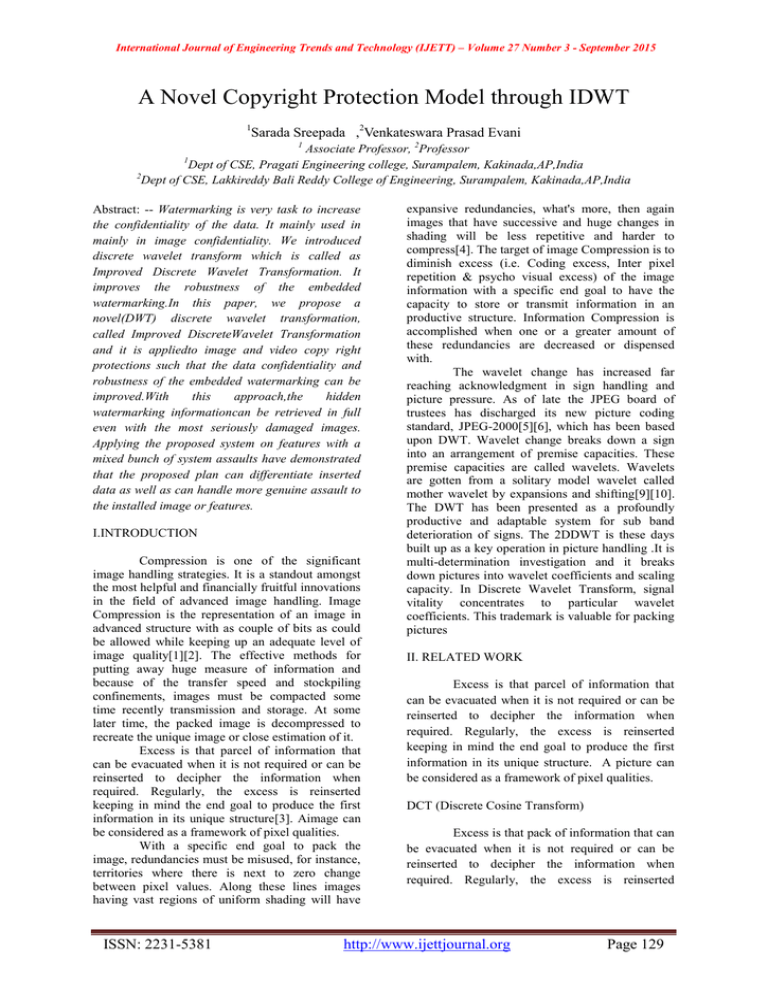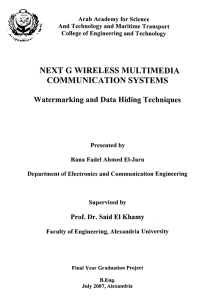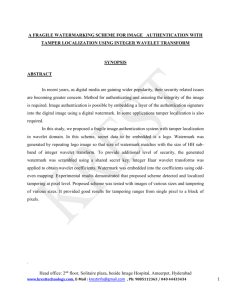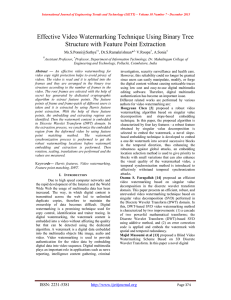Document 12913206
advertisement

International Journal of Engineering Trends and Technology (IJETT) – Volume 27 Number 3 - September 2015 A Novel Copyright Protection Model through IDWT 1 Sarada Sreepada ,2Venkateswara Prasad Evani 1 Associate Professor, 2Professor Dept of CSE, Pragati Engineering college, Surampalem, Kakinada,AP,India 2 Dept of CSE, Lakkireddy Bali Reddy College of Engineering, Surampalem, Kakinada,AP,India 1 Abstract: -- Watermarking is very task to increase the confidentiality of the data. It mainly used in mainly in image confidentiality. We introduced discrete wavelet transform which is called as Improved Discrete Wavelet Transformation. It improves the robustness of the embedded watermarking.In this paper, we propose a novel(DWT) discrete wavelet transformation, called Improved DiscreteWavelet Transformation and it is appliedto image and video copy right protections such that the data confidentiality and robustness of the embedded watermarking can be improved.With this approach,the hidden watermarking informationcan be retrieved in full even with the most seriously damaged images. Applying the proposed system on features with a mixed bunch of system assaults have demonstrated that the proposed plan can differentiate inserted data as well as can handle more genuine assault to the installed image or features. I.INTRODUCTION Compression is one of the significant image handling strategies. It is a standout amongst the most helpful and financially fruitful innovations in the field of advanced image handling. Image Compression is the representation of an image in advanced structure with as couple of bits as could be allowed while keeping up an adequate level of image quality[1][2]. The effective methods for putting away huge measure of information and because of the transfer speed and stockpiling confinements, images must be compacted some time recently transmission and storage. At some later time, the packed image is decompressed to recreate the unique image or close estimation of it. Excess is that parcel of information that can be evacuated when it is not required or can be reinserted to decipher the information when required. Regularly, the excess is reinserted keeping in mind the end goal to produce the first information in its unique structure[3]. Aimage can be considered as a framework of pixel qualities. With a specific end goal to pack the image, redundancies must be misused, for instance, territories where there is next to zero change between pixel values. Along these lines images having vast regions of uniform shading will have ISSN: 2231-5381 expansive redundancies, what's more, then again images that have successive and huge changes in shading will be less repetitive and harder to compress[4]. The target of image Compression is to diminish excess (i.e. Coding excess, Inter pixel repetition & psycho visual excess) of the image information with a specific end goal to have the capacity to store or transmit information in an productive structure. Information Compression is accomplished when one or a greater amount of these redundancies are decreased or dispensed with. The wavelet change has increased far reaching acknowledgment in sign handling and picture pressure. As of late the JPEG board of trustees has discharged its new picture coding standard, JPEG-2000[5][6], which has been based upon DWT. Wavelet change breaks down a sign into an arrangement of premise capacities. These premise capacities are called wavelets. Wavelets are gotten from a solitary model wavelet called mother wavelet by expansions and shifting[9][10]. The DWT has been presented as a profoundly productive and adaptable system for sub band deterioration of signs. The 2DDWT is these days built up as a key operation in picture handling .It is multi-determination investigation and it breaks down pictures into wavelet coefficients and scaling capacity. In Discrete Wavelet Transform, signal vitality concentrates to particular wavelet coefficients. This trademark is valuable for packing pictures II. RELATED WORK Excess is that parcel of information that can be evacuated when it is not required or can be reinserted to decipher the information when required. Regularly, the excess is reinserted keeping in mind the end goal to produce the first information in its unique structure. A picture can be considered as a framework of pixel qualities. DCT (Discrete Cosine Transform) Excess is that pack of information that can be evacuated when it is not required or can be reinserted to decipher the information when required. Regularly, the excess is reinserted http://www.ijettjournal.org Page 129 International Journal of Engineering Trends and Technology (IJETT) – Volume 27 Number 3 - September 2015 keeping in mind the end goal to produce the first information in its unique structure[7][8]. A picture can be considered as a framework of pixel qualities. The below presented the general overview of the image process. 1. The image is broken into 8X8 blocks of pixels. 2. Working from left to right, top to bottom, the DCT is applied to each block. 3. Each block is compressed through quantization. 4. The array of compressed blocks that constitute the image is stored ina reduced amount of space. 5. When desired, the image is reconstructed through decompression, a method that inverse descrete cosine transform. III. IMPROVED TRANSFORM DISCRETE WAVELET inImproved Discrete Wavelet Transformation, the water marking scheme is to transform the pixels of the image. In watermarking the security and imperceptibility is the important concern about the hidden information and it will meet the security requirement. The method distributes the information to be hidden in the coefficients. L′containing summed pixels represent low-pass subband coefficients; H′containing subtracted pixels represent high-pass subband coefficients. The combination of the L′and H′forms S′. STEP2 Vertically process From the S′format which is resulted by the process in the initial separation, divide the L′and H′into two blocks then get left-top block LL and left-down block LH in L′; right-top block HL and right-down block HH in H′. The length of row of LL and the length of column of LL are M/2 . The size of LH,HL,and HH are the same as LL. We reimplements the coordinates of LH,HL,and HH, for example, LH(0,0) = S′(M/2,0), LH(M/2−1,0) =S′(M−1,0), HL(0,0) = S′(0,M/2 ), HL(M/2−1,0) = S′(M/2−1,M/2 −1),HH(0,0) = S′(M/2 ,M/2), HH(M/2−1,0) = S′(M−1,M/2 ),etc. (Vertically process) Input:LL(i,j), LH(i,j) , HL(i,j), HH(i,j) Output: LL′, LH′, HL′, HH′are the results of process with LL, LH , HL, HH. For i:= 0 to M/2 − 1 do Begin For j=0 to M/2 − 1 do Begin LL′(i,j) = LL(i,j) + LH(i,j); LH′(i,j) = LL(i,j) - LH(i,j); HL′(i,j) = HL(i,j) + HH(i,j); HH′(i,j) = HL(i,j) - HH(i,j); End End STEP1 Horizontally process With the first picture in spatial space, isolate the first picture S(M × M) on a level plane into two equivalent pieces, then get left square L and right square H. The length of line of L is M and the length of segment of L is M/2. The measure of H is the same as L and we remake the directions of H, for instance, H(0,0) = S(0,M/2 ), H(M−1,0) = S(M−1,M/2 ),and so forth. The diagrammatic representation of subject Fig. 3. ( Horizontally process ) Input: L(i,j), H(i,j) are the (i, j)th pixel of L, H. Output: L′, H′are the results of process with L, H. For i:= 0 to M − 1 do Begin For j=0 to M/2 − 1 do Begin L′(i,j) = L(i,j) + H(i,j); H′(i,j) = L(i,j) - H(i,j); End End ISSN: 2231-5381 Fig. 4 Illustration each sub band’s pixel with corresponding source pixel Fig. 5 (a) The original image (b) The result of 1scale PDWT transform (c)The result of 2-scale PDWT transform (d)The result of 3-scale PDWT transform LL′containing add values from the L block in the initial step is the low frequency part in that low frequency portion; LH′ consisting ofintersection values from the L block in the first http://www.ijettjournal.org Page 130 International Journal of Engineering Trends and Technology (IJETT) – Volume 27 Number 3 - September 2015 step is the more frequency part in that low frequency part. The combination of the LL′, LH′,HL′,and HH′forms S′′. STEP3 Repeat STEP1 and STEP2 K times With PDWT, in every scale of the PDWT transform, we take left-right neighbouring pixels to perform STEP1 and STEP2 operation to obtain four subbands, and denoted them LL, LH, HL, and HH respectively. Each of the sub- bands shows the various frequency range. LL subband is the focus of the mechanism because in the next step, LL subband will be divided into three other sub-bands. The resultant of K-scale PDWTchange is created by the STEP1 and STEP2 operation in the (K − 1)-scale PDWT transform’s sub-band LL. The result is 10 sub bands for 3-scale PDWT transform, Embedding and Extracting algorithm Based on the above multi-scale PDWT transform, we propose a digital watermarking scheme for intelligence property. The methods for embedding and retrieving watermark are shown below. Embedding algorithm The method of the embedding algorithm is as shown below: STEP1 Input the cover image S(M ×M) to be embedded and watermark image W(N × N). STEP2 With S, perform K-scale PDWT transform, where K shows the number of scale and t the strength coefficient. STEP3 Take the LH and HL of the last scale PDWT transform result and process the embedding pixels in the frequency domain: IF (W(i,j) = 0) then HL(i,j) = HL(i,j) + (2K)2t; (1) IF (W(i,j) = 1) then LH(i,j) = LH(i,j) + (2K)2t; (2) STEP4 Repeat the STEP3 until all the watermark information are processed. STEP5 InversePDWT to obtain the stego-image E. Extracting algorithm The process of the extracting algorithm is as follows: STEP1:Input the stego-image E and the original image S(M ×M). STEP2: Calculate the length of image data for a single extracting process l, l = M/(2K−1) . STEP3:Divide E and S with block length l into sub blocks. Each image can be divided into p subblocks, p = ((2K−1)2). STEP4: Subtract the corresponding pixel values of the sub-blocks from E and S and set the results to an element of array V . STEP5:With the array V , divide it into four square sub-blocks with length of l/2 . The sub-blocks are named from left to right, top to bottom as LL, HL, LH, HH. ISSN: 2231-5381 STEP6: Extract the individual pixel of the embedded watermark. IF (LL(i,j)> 0 and LH(i,j)> 0) then W(i,j) = 1; (3) IF (LL(i,j)> 0 and HL(i,j)> 0) then W(i,j) = 0; (4) STEP7: Repeat the STEP6 until the sub-blocks of the K-scale are processed. For providing We can enhance the system by PDWT lifting and Mary modulator. In the QIM based data hiding scheme, it is a challenging task to embed multiple bits of information into the host signal. The present work proposes a new model of the QIM i.e. M-ary amplitude modulation principle for multibit watermarking. The watermark embedding process may be divided into two phases. In the first phase, a binary watermark image is spatially dispersed using a sequence of numbers generated by a secret key. In the second phase, host image is decomposed by lifting and the encoded watermark bits are embedded into high– low (HL) and low–high (LH) sub-bands of DWTcoefficients using M-ary amplitude modulation. Simulation results show that robustness is increased more, of course at the cost of increase in decoding complexity for high M-value. IV. COCLUSION In this paper, we display a change method on watermarking contrasts from discrete wavelet change; with the reason that gives an establishment to a more secured watermarking method. Not quite the same as the beforehand proposed watermarking method, that uses discrete wavelet change, which accentuation on adapting with image compression norms however yields the essential prerequisite of watermarking security. We go for an offset on both picture pressure benchmarks and security of watermarking. Such that not just the security of data can be held additionally acquired the operational productivity and accommodation through the utilization of advanced watermarking. Thusly, the data can be utilized on more applications and legitimate scholarly properties can likewise be protected. REFERENCES [1] S. D. Lin, and C. F. Chen, ‖A Robust Dct based Watermarking for Copyright Protection,‖ IEEE Transaction on Consumer Electronics, vol. 46. No. 3. pp. 415-421,2000. [2] J. Lee, and C. S.Won, ‖AWatermarking Sequence Using Parities of Error Control Coding for Image Authentication and Correction,‖ IEEE Transactions on ConsumerElectronics, vol. 46. No. 2. pp. 313-317, 2000. [3] Robert Ulichney, ‖Digital Halftoning,‖ The MIT Press, 1987. http://www.ijettjournal.org Page 131 International Journal of Engineering Trends and Technology (IJETT) – Volume 27 Number 3 - September 2015 [4] C. Y. Lin, M. Wu, J. A. Bloom, I. J. Cox, M. L. Miller,and Y. M. Lui, ‖Rotation, Scale and Translation resilientwatermarking for images,‖ IEEE Transactions on ImageProcessing, vol. 10. No. 5, 2001. [5] F. Y. Shih and S. Y. T. Wu, ―Combinational image watermarking inthe spatial and frequency domains,‖ Pattern Recognit., vol. 36, pp.969–975, 2003. [6] Q. Li and I. J. Cox, ―Using perceptual models to improve fidelity andprovide resistance to valumetric scaling for quantization index modulationwatermarking,‖ IEEE Trans. Inf. Forensics Security, vol. 2, no.2, pp. 127–139, Jun. 2007. [7]. E. Reiner, ‖Recent Progress in Digital Halftoning,‖ Recent Progress in Digital Halftoning II, Reprinted from IS&T Proceedings, pp. 9-11, 1999. [8]. C. F. Wu, and W. S. Hsieh, ‖Digital watermarking UsingZerotree of DCT,‖ IEEE Transactions on Consumer Electronics, vol. 46. No. 1. pp. 87-94, 2000. [9]. H. Inoue, A. Miyazaki, and A. Yamamoto, ‖A digitalwatermarking based on the wavelet transform and itsrobustness on image compression,‖ Proceeding of IEEEinternational conference on Image Processing, vol. 2. pp.391-395, 1998. [10]. H. Inoue, A. Miyazaki, and T. Katsura, ‖Wavelet basedwatermarking for tampering proofing of still images,‖IEEE Int. Conf. on Image Processing, vol. 2. pp. 8891,2000. BIOGRAPHIES Venkateswara Prasad Evani is currently the director at Lakkireddy Bali Reddy College of Engineering, Andhra Pradesh, India. Prior to his current assignment, he was the Rector at Jawaharlal Nehru Technological University Kakinada, Andhra Pradesh, India. He received his PhD degree in computer science and engineering from the University of Roorkee, ISSN: 2231-5381 Uttarakhand, India, in 1990. He received his ME degree in computer science from Madras University, Chennai, India, in 1978 and his BE degree in electronics and communication engineering from Sri Venkateswara University, Andhra Pradesh, India, in 1975. He has thirtyfive years of experience in teaching undergraduate and post-graduate students. He held different positions in his career, such as vice principal, principal, director, registrar, and chairman of the board of studies. He has guided seven students toward PhD degrees, co-authored six books, and published 102 research publications to date in national and international journals and conferences. He was the recipient of the ―State Best Teacher‖ award in 2008 — an award that is given to meritorious teachers by the government of Andhra Pradesh, India. His research interests include Improved computing, data mining, image processing, and information security. SaradaSreepadais currently working inPragati Engineering college, Surampalem, Kakinada as an Associate Professor. She obtained her M.Tech. degree from JNTUK, Kakinada in Computer Science Engineering. She is presently pursuing her study in the area of watermarking and Steganography. Her research interests include Information security, Image Processing, Neural Networks and Artificial Intelligence. http://www.ijettjournal.org Page 132






